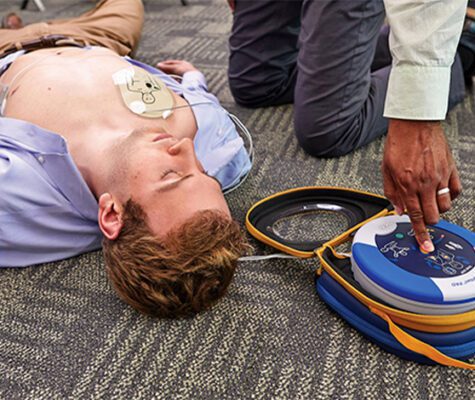What is a Defibrillator?
A defibrillator is a potentially lifesaving device used to give an electric shock or pulse to someone whose heart is suffering Sudden Cardiac Arrest (SCA). Common types of defibrillators include AEDs and manual medical defibrillators.
RxList, part of the WebMD group, defines defibrillation as:
“The use of a carefully controlled electric shock, administered either through a device on the exterior of the chest wall or directly to the exposed heart muscle, to normalize the rhythm of the heart or restart it.”
Learn more about defibrillators, usage, application, and maintenance in our AED resource hub.
Read moreIntroduction to Defibrillators
The types of defibrillators
There are five key types of defibrillators:
- Automated External Defibrillators (AED) can be used by anyone to send a lifesaving electrical shock to a person’s heart during Sudden Cardiac Arrest (SCA).
- Manual external defibrillators are most commonly found in medical settings and can only be used by trained medical professionals.
- Implantable cardioverter-defibrillator (ICD) is a device similar to a pacemaker and is used as a preventative treatment on those thought to be at risk from an imminent heart attack.
- Manual internal defibrillators are used in operating rooms to restart the heart, but only when the ribcage is open. Paddles are used to send the electric shock directly onto the heart muscles.
- Wearable cardioverter defibrillator is a vest that contains an electrocardiogram-monitoring system and an external automatic defibrillator, commonly used before surgery to fit an ICD.
Each of these defibrillators serve a common purpose, which is to restart a person’s heart, but they all do it in different ways.
Most people will only ever come into contact with an AED, and these are found in public spaces in easily accessible points across the UK. Schools, community buildings, offices, and supermarkets, as well as sports clubs and more, will often have an AED.
What is an AED?
An AED, or Automated External Defibrillator, is a medical device that can listen to a person’s heartbeat, notice arrhythmia (irregular heart patterns) and automatically transmit an electric shock designed to set a person’s heartbeat back to its normal rhythm.
They can be found in publicly accessible places such as offices, public buildings and converted phone boxes, or community buildings across the UK.
AEDs, sometimes referred to as PADs (Publicly Accessible Defibrillators), are either automatic or semi-automatic.
What is the difference between an automatic and semi-automatic AED?
Automatic AEDs cover the entire process, including delivering a shock. This means they offer instructions for CPR through to delivering the potentially lifesaving electric shock. The AED will often have a speaker to talk the responder through the process, including when to perform CPR.
A semi-automatic AED will do everything that an automatic AED does, but it will not deliver the shock. Instead, it will instruct the user to deliver the shock mostly through the push of a button.
How available are AEDs in the UK?
Compared to other countries, AED availability and awareness is lacking in the UK, and the low national survival rates of Sudden Cardiac Arrest reflect this.
For instance, Seattle, USA boasts a survival rate from SCA of above 60% and the Netherlands has achieved more than 20%, when compared with the UK at only 5 to 10%.
What is the purpose of a defibrillator?
A defibrillator, when used in time and correctly, will ensure that the chances of surviving sudden cardiac arrest are much higher. Without a defibrillator or immediate CPR, the chances of survival reduce by 7-10% every minute.
Defibrillators also allow for the general public to help in the case of a cardiac arrest, without the need for medical training.
How does a defibrillator work?
A defibrillator works by sending an electrical current in the form of a high voltage shock through a person’s heart, which depolarizes the heart muscles and forces the body’s natural rhythms to re-establish a correct rhythm.
Will a defibrillator restart a heart?
No, a defibrillator will not restart a heart. Instead, it shocks the heart back into normal rhythm. During Sudden Cardiac Arrest, the heart beats irregularly in what is known as ventricular fibrillation. As there is still a heartbeat, a defibrillator can be used.

Defibrillator Differences
How is an AED different from a manual defibrillator?
An AED is different to a manual defibrillator as it delivers a potentially lifesaving shock either automatically, or at the press of a button. Where manual defibrillators can only be used by medical professionals, AEDs can be used by members of the public who have no prior training. They deliver shocks and detect heart rate automatically, meaning that most of the work is done by the machine rather than the responder.
What is the difference between an AED and a pacemaker?
The difference between an AED and a pacemaker is the circumstances for when they are used.
A pacemaker is fitted to a person who has ongoing heart concerns, and helps to regulate the heartbeat, greatly increasing the quality of life for many people.
An AED, however, is used to shock a heart back into normal rhythm and is only used in emergency situations.

Using a Defibrillator
Who can use a defibrillator?
While anyone can use an AED, providing defibrillator training can help volunteers, staff, or others to feel more confident when using a defibrillator, should they ever need to.
A medical defibrillator however, where two independent paddles are used, should only be used by trained medical professionals.
When should you use a defibrillator?
A defibrillator should be used when someone suffers from Sudden Cardiac Arrest.
Sudden Cardiac Arrest is not a ‘flat line’. Instead, it is when the heart beats irregularly to the point that the heart cannot pump blood around the body, medically called arrhythmia. There are different types of arrythmia, but the most common one that causes SCA is known as ventricular fibrillation.
Can an AED be used on a child or infant?
In some cases, an AED can be used on a child or infant if it is designed for child use. In first aid terms, a child is between the ages of one and eight. For a baby under the age of one, a defibrillator should not be used. Some defibrillators come with child-ready pads, which deliver a lesser shock. Places that have large groups of children, such as community halls, schools, nurseries, and hospitals, should have a variety of defibrillators for different age groups. Pads for children can be ordered separately.
Do you need to carry out CPR and use a defibrillator?
Yes, you do need to carry out CPR as well as using an AED if someone is suffering from cardiac arrest. CPR is the first lifesaving step and should happen immediately when someone goes into cardiac arrest while a defibrillator is being located.
When the defibrillator delivers a shock, anyone carrying out CPR must step back and stop touching the patient as it is dangerous and may affect the performance of the shock.
Looking For A Defibrillator Supplier With End-to-End Support?
Aero Healthcare focuses on providing the highest quality products and support at every point of your journey, including training and installation. Get in touch with us today.

Get in Touch
Fill out the form, and we’ll get in touch.

